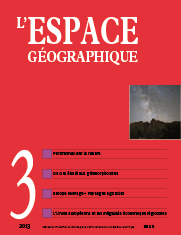

“Half the park is after dark”. Dark sky parks and reserves: new
concepts and tools to grant nature heritage status (2 photos, 2 tabl.)
There currently exists 44 dark sky parks and reserves (also known as ‘‘starlight reserves’’. Rarely created from nothing, they are often founded within already protected spaces (natural monuments, national parks, biosphere reserves...) whose protective measures are thus increased to include starry skies and nocturnal environments. Parks englobe the area in its entirety whereas reserves designate a core protected area within a larger space. Their creation illustrates the emergence of new forms of protection and the development of natural heritage whose concepts are rapidly spreading throughout European countries.
keyword: DARK SKY, LIGHT POLLUTION, PARK, RESERVE, WILDERNESS
Heritage and ordinary abiotic nature. Considerations based on case studies in the Pays de la Loire (France)(4 fig.)
This paper deals with the new heritage perceptions of abiotic nature (geological and geomorphological). Its concerns a regional context associated with landscapes which are sometimes considered as “ordinary” because of the ‘‘flat country’’ topography. Three case studies mark out the reflexions: Brière’s swamps and the Alpes mancelles, both integrated into regional natural parks, illustrate the importance of the convergence of scientific and institutional perceptions in the allocation of heritage values; work done by associations on the Vendée coast within the framework of educational fieldtrips show while the perceptions of specialists are essential for the heritage to emerge, they are also effectively transmitted by these organizations.
keyword: ACQUISITION OF HERITAGE STATUS, ORDINARY NATURE, GEOMORPHOLOGICAL HERITAGE, PAYS DE LA LOIRE
Registering intensive agriculture landscapes as heritage: the Plaine de Versailles and its “association patrimoniale” (3 fig.)
In the Plaine of Versailles, intensive cereal agriculture has taken on all the attributes of a common landscape heritage. This paper insists on the emergence of new representations of agricultural landscape since 1970’s. In particular, three processes can be brought to light: new representations of agricultural spaces in urban planning policies; new social demand or desire for multi-form agriculture; and a process of naturalization, with the expansion of ecological values and social practices of “nature”. At the end, these changes build the story of a landscape creation, beyond the Versailles palace, which brings together projects to improve the living environment in this peri-urban area.
keyword: AGRICULTURE, LANDSCAPE, NATURALIZATION, PERIURBAN, TERRITORIALIZATION, VERSAILLES
Granting nature and landscapes heritage status: contradictions and paradoxes concerning the fluvial wing dykes of the Armorican Loire (2 fig., 4 photos)
In the minor riverbed of the Loire River between Angers and Nantes, 700 wing dykes were established in the early twentieth century to improve navigation. Today these structures are considered partially responsible for the lowering of water levels and for the accompanying loss of biodiversity and increased instability of engineering structures. In order to restore the river's morphology and its associated wetlands, Voies navigables de France – as part of the Plan Loire Grandeur Nature – launched a project to reshape these wing dykes in 2009 over approximately ten kilometers. Will the decommissioning of fluvial wing dykes and their re-shaping – which could initiate a deconstruction project over the long term – trigger a new appreciation of these structures specific to the Armorican Loire, a vision tied to conservation and heritage status?
keyword: HERITAGE VALUE, LANDSCAPE REPRESENTATION, MODEL OF PERCEPTION, WING DYKE
(1 encadré, 1 fig., 1 tabl.)
This article takes stock of efforts to grant heritage status to nature that highlight ideas of of wildnerness, as well as proning the preservation of the spontaneity of biophysical processes along with reconquering of spaces with exceptional levels of naturality. Based on such an overview, we evaluate the degree of filiation between the North American and the more recent European concepts of wildnerness. We examine the European movement to promote wildnerness, notably key actors and modes of actions. Finally, we consider the political integration of the ideal construction of European wildnerness and various strategies to reconquer vast expanses of wildnerness.
keyword: EUROPE, HERITAGE, NATURALNESS, NATURE, PRESERVATION, WILDERNESS
For a geographical approach of convergence. Regional disparities in the European Union and their evolution (1 encadré, 4 fig.)
The aim of this paper is to lay the conceptual and methodological foundations for a theory of economic convergence. Taking into account the spatial dimension when evaluating convergence is from this point of view an interesting perspective in the field of the geography. The index of local economic convergence proposed makes it possible to measure the simultaneous processes of economic convergence and divergence occurring in the European Union. By comparing the two periods 1995-2000 and 2000-2006 for all the European regions at the NUTS 23 level, it can be seen that there are situations of regions that have evolved in a favorable or unfavorable manner from the economic point of view. The spatial structure of these local economic convergence or divergence phenomena is very clear and reflects a true geography of the evolution of regional inequalities in the European Union.
keyword: CONVERGENCE, EUROPEAN UNION, REGIONAL DISPARITY REGIONAL GROWTH, SPATIAL ANALYSIS
Book reviews
In this issue of l’Espace géographique, you will find critical reviews of the following books
MARCUS J., SABLOFF J.A. (eds)(2008). The Ancient City. New Perspectives on Urbanism in the Old and New World. Santa Fe: School for Advanced Research Press, coll. «A School for Advanced Research Resident Scholar Book», 405 p. (Denise Pumain, université Paris 1 Panthéon-Sorbonne) ISBN: 978-1-934691-02-1
FERRIER J.-P. (2013). La Beauté géographique, ou la métamorphose des lieux. Paris: Economica, 132 p. (Yves Guermond, université de Rouen) ISBN: 978-2-7178-6558-5
L’espace géographique 2/13![]()
![]() L’espace géographique 4/13
L’espace géographique 4/13
For subscribe or buy this issue: BELIN
![]() L’Espace géographique: contents
L’Espace géographique: contents
Last modified: January 17, 2014